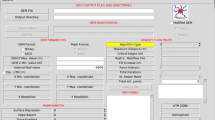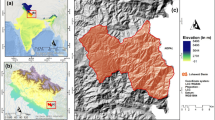Abstract
Digital elevation models (DEMs) used in geospatial analysis like the simulation of geophysical flows, such as floods, landslides, and block and ash flows, differ in resolution, acquisition time and generation methodology, which results in varied representation of topographic features. This study investigates the effects of DEMs on the output of a granular flow model, TITAN2D by comparing the output using different DEMs to that obtained with a “true” representation of the terrain, which is considered to be that obtained by using TOPSAR 5 m data. Seven DEMs at four resolutions from four sources were used for Mammoth Mountain, California, a cumulodome volcano. TITAN2D was run for seven different locations of an eruption of a potential dome and two different collapse volumes. The resulting outputs were subsequently compared with TOPSAR 5 m output, and qualitative and statistical inferences were drawn. DEMs with different resolutions and sources generated different outputs that led to different flow maps. For moderate and smaller scale flows (\(\mathcal{O}(10^4)\) m3 – \(\mathcal{O}(10^5) \,\text{m}^3\)), different representations can affect the computation of accurate footprint of the flow and fine DEM resolution is critical for correct characterization of these flows.





Similar content being viewed by others
References
Abrams M (2000) The advanced spaceborne thermal emission and reflection radiometer (ASTER): data products for the high spatial resolution imager on NASAs terra platform. Int J Remote Sens 21:847–859
Bailey RA (1989) Geologic map of long valley caldera, mono-inyo craters volcanic chain and vicinity, eastern California. Department of the Interior, Reston, VA
Barr DR, Davidson T (1973) A Kolmogorov-Smirnov test for censored samples. Technometrics 15:739–757
Bates PD, De Roo APJ (2000) A simple raster-based model for flood inundation simulation. J Hydrol 236:54–77
Binh TQ, Thuy NT (2008) Assessment of the influence of interpolation techniques on the accuracy of digital elevation model. VNU J Sci Earth Sci 24:176–183
Biswas S, Ahmad S, Molla MKI, Hirose K, Nasser M (2008) Kolmogorov-Smirnov test in text-dependent automatic speaker identification. Eng Lett 16:4
Burkett SM (2007) Geomorphic mapping and petrography of Mammoth Mountain, California. Master’s thesis, State University of New York at Buffalo
Capra L, Manea VC, Manea M, Norini G (2011) The importance of digital elevation model resolution on granular flow simulations: a test case for Colima volcano using TITAN2D computational routine. Nat Hazards 59:665–680
Cebecauer T, Hofierka J, Suri Marcel (2002) Processing digital terrain models by regularized spline with tension: tuning interpolation parameters for different input datasets. In: Proceeding of open source GIS—GRASS users conference
Chanbey I, Cotter AS, Costello TA, Soerens TS (2005) Effect of DEM data resolution on SWAT output uncertainty. Hydrol Process 19(3):621–628
Cochrane TA (1999) Methodologies for watershed modeling with GIS and DEMs for the parametrization of the WEPP model. PhD thesis, Purdue University
Congalton RG (2005) Thematic and positional accuracy assessment of digital remotely sensed data. In: Proceedings of the 7th annual forest inventory and analysis symposium
Desmet PJJ, Grovers G (1997) Comment on modeling topographic potential for erosion and deposition using GIS. Int J Geogr Inf Syst 11:603–610
Farr TG, Rosen PA, Caro E, Crippen R, Duren R, Hensley S, Kobrick M (2007) The shuttle radar topography mission. Technical report, Jet Propulsion Laboratory
Farrar CD (1995) Forest-killing diffuse co 2 emission at Mammoth Mountain as a sign of magmatic unrest. Nat Biotechnol 376:675
Fisher P, Tate NJ (2006) Causes and consequences of error in digital elevation models. Prog Phys Geogr 30:467–489
Florinsky IV (1998) Combined analysis of digital terrain models and remotely sensed data in landscape investigations. Phys Geogr 22
Fujisada H, Bailey GB, Kelly GG, Hara S, Abrams MJ (2005) ASTER DEM performance. IEEE Trans Geosci Remote Sens 43:2707–2714
Galas S, Dalbey K, Kumar D, Patra AK, Sheridan M (2007) Benchmarking TITAN2D mass flow model against a sand flow experiment and the 1903 Frank slide. The 2007 international forum on landslide disaster management, Ho & Li editors
Gesch D, Evans G, Mauck J, Hutchinson J, Carswell WJ Jr (2009) The National map elevation: U.S. Geological Survey Fact Sheet 2009-3053, 4 p
Goncalves JA, Oliveira AM (2004) Accuracy analysis of DEMs derived from ASTER imagery. ISPRS XX, Istanbul, Turkey
Hooper DM, Bursik MI, Webb FH (2003) Application of high-resolution, interferometric DEMs to geomorphic studies of fault scarps, Fish Lake Valley, Nevada-California, USA. Remote Sens Environ 84(2):255–267
Jenson SK, Dominque JO (1988) Extracting topographic structure from digital elevation data for geographic information saystem analysis. Photogramm Eng Remote Sens 54:1593–1600
Kamada M, Toraichi K, Mori R (1988) Periodic spline orthonormal bases. J Approx Theory 55:27-34
Kvasov B (2011) Parallel mesh methods for tension splines. J Comput Appl Math 236:843–859
Lajeunesse E, Mangeney-Castelnau A, Vilotte JP (2004) Spreading of a granular mass on a horizontal plane. Phys Fluids 16:2371–2381
Legorreta-Paulin G, Bursik MI (2009) Assessment of landslides susceptibility. VDM and Co. KG, Saarbrucken, Germany
Lillesand TM, Keifer RW (2000) Remote sensing and image interpretation. 4th edn. Wiley, New York, NY
Lopes RHC, Reid I, Hobson PR (2007) The two-dimensional Kolmogorov–Smirnov test. XI international workshop on advanced computing and analysis techniques in physics research
Lube G, Huppert HE, Sparks RSJ, Hallworth MA (2004) Axisymmetric collapses of granular columns. J Fluid Mech 508:175-199
Mitasova H, Hofierka J (1993) Interpolation by regularized spline with tension: Application to terrain modeling and surface geometry analysis. Math Geol 25:657–669
Mitasova H, Hofierka J, Zlocha M, Iverson LR (1996) Modeling topographic potential for erosion and deposition using GIS. Int J Geogr Inf Syst 10:629–641
Mouginis-Mark PJ, Garbeil H (2005) Quality of TOPSAR topographic data for volcanology studies at Kilauea Volcano, Hawaii: an assessment using airborne LiDAR data. Remote Sens Environ 96:149–164
Patra AK, Bauer AC, Nichita CC, Pitman EB, Sheridan MF, Bursik M, Rupp B, Webber A, Stinton AJ, Namikawa LM, Renschler CS (2005) Parallel adaptive numerical simulation of dry avalanches over natural terrain. J Volcanol Geotherm Res 139:1–21
Procter JN, Cronin SJ, Fuller IC, Sheridan MFM, Neall VE, Keys H (2010) Lahar hazard assessment using TITAN2D for an alluvial fan with rapidly changing geomorphology: Whangaehu River, Mt Ruapehu. Geomorphology 116(1–2):162–174
Savage SB, Hutter K (1989) The motion of a finite mass of granular material down a rough incline. J Fluid Mech 199:177–215
Shaffer WJ (2006) Evaluation of the shuttle radar topography mission digital elevation model and application to the modeling of permanent deformation. Master’s thesis, State University of New York at Buffalo
Stevens NF, Manville V, Heron DW (2006) The sensitivity of a volcanic flow model to digital elevation model accuracy: experiments with digitised map contours and interferometric sar at Ruapehu and Taranaki volvanoes, New Zealand. J Volcanol Geotherm Res 119:89–105
Takahashi T, Tsujimoto H (2000) A mechanical model for Merapi-type pyroclastic flow. J Volcanol Geotherm Res 98:91–115
Wise SM (2007) Effect of differing DEM creation methods on the results from a hydrological model. Comput Geosci 33:1351–1365
Wolock DM, Price CV (1994) Effects of digital elevation model map scale and data resolution on a topography-based watershed model. Water Resour Res 30(11):3041–3052
Xiao LL, Liu HB, Zhao XG (2010) Impact of digital elevation model resolution on stream network parameters. In: 2nd Conference of environmental science and information application technology
Zhang WH, Montgomery DR (1994) Digital elevation model grid size, landscape representation and hydrologic simulations. Water Resour Res 30(4):1019–1028
Zhang JX, Chang KT, Wu JQ (2008) Effects of DEM resolution and source on soil erosion modelling: a case study using the WEPP model. Int J Geogr Inf Sci 22(8):925–942
Acknowledgments
This research was supported by NASA grant NNX08AF75G. We would like to thank Keith Dalbey for his invaluable comments and feedback.
Author information
Authors and Affiliations
Corresponding author
Rights and permissions
About this article
Cite this article
Stefanescu, E.R., Bursik, M. & Patra, A.K. Effect of digital elevation model on Mohr-Coulomb geophysical flow model output. Nat Hazards 62, 635–656 (2012). https://doi.org/10.1007/s11069-012-0103-y
Received:
Accepted:
Published:
Issue Date:
DOI: https://doi.org/10.1007/s11069-012-0103-y




